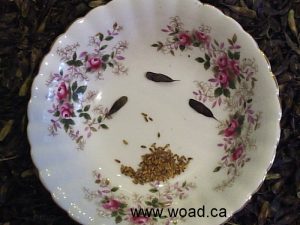With Spring just around the corner, some will be thinking dye garden time. Some dye plants can be started indoors, and others do best started in the garden. Some dye plants are annuals, others are biannual, and still others are perennials. All give interesting colours, and all are fun to grow and use.
If you haven’t yet begun planning your summer dye garden you can check out these posts on Planning your Natural Dye Garden, Part One, and Part Two.
Germination Test
New seed doesn’t need to be purchased every single year. A simple germination test can show what seed is still viable enough to plant, and what seed is no longer viable.
- Take about ten seeds, and wrap them in a wet paper towel.
- Place the paper towel in a Ziploc bag
- Place bag in a warm location
- Wait for germination to occur
- Germination should occur any time after three days to two weeks
Anything above fifty % germination rate is alright to plant. If the germination rate is below 80% increase the planting density, slightly. If it is below 50% you can still plant the seed, but plant very thickly.
Not all seeds are that easy, however. Some seeds have germination inhibitors, or really thick skins/shells that prevent water from penetrating. In these cases, the seed should be soaked before being tested.
Woad
Woad is a biannual and a classic case of seed with a built in germination inhibitor. It is easy to start outdoors, with planting being around the same time as the peas and lettuce. Woad’s germination inhibitor must be washed off by rain, or watering before the seeds can germinate. This is one of the reasons why woad can become invasive, because the seeds wait till there is enough water to flourish before they germinate.
To germination test Woad seed, you need to remove the outer cover. Woad’s actual seed is about the size of a mustard or canola seed, and is in the center of the dark purplish cover. It is the cover that contains the inhibitor, so removing it will permit the seed to germinate faster for the test. If you don’t want remove the seed cover, then soaking and rinsing the seed a few times should remove the majority of the germination inhibitor.
Back to You
What experience have you had with your natural dye garden? What advice would you give to a new natural dye gardener? What advice do you wish you had received as a beginning natural dye gardener? I would love to hear your story. Leave a comment.

Thanks for the great information! I was wondering if I could get your advice on where to buy seeds for natural dyes? I see that you have Woad, but I am looking for many others. Japanese Indigo, Madder, Weld, plus a whole bunch of flowers. It doesn’t seem like there are any go to resources out there. Any ideas of a reliable web site to order from?
Hi Katie
Most seed companies will have some plants that double as natural dyes. Yarrow and Chamomile are in most herb seed catalogs. If you are in Canada you can try Richters Herbs for madder and a fair number of other dye plant seeds as well. I think they carry weld, but am not sure on the Japanese Indigo. Baker Creek Heirloom Seed Company in the US also has some dye plants among their other plants – like Hopi Black Dye Sunflower.
Hope that helps, thank you for commenting.
Sarah